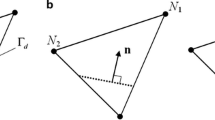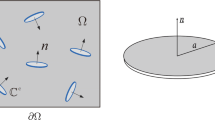Abstract
Based on elasto-plasticity and damage mechanics, a double-medium constitutive model of geological material under uniaxial tension and compression was presented, on the assumption that rock and soil materials are the pore-fracture double-medium, and porous medium has no damage occurring, while fracture medium has damage occurring with load. To the implicit equation of the model, iterative method was adopted to obtain the complete stress-strain curve of the material. The result shows that many different distributions (uniform distribution, concentrated distribution and random distribution) of fractures in rock and soil material are the essential reasons of the daedal constitutive relations. By the reason that the double-medium constitutive model separates the material to be porous medium part, which is the main body of elasticity, and fracture medium part, which is the main body of damage, it is of important practical values and theoretical meanings to the study on failure of rock and soil or materials containing damage.
Similar content being viewed by others
References
Wu Yanqing, Zhang Zhuoyuan. An Introduction to Rock Mass Hydraulics[M]. South-west Jiao Tong University Press, Chengdu, 1995 (in Chinese).
Liu Xiaoli. Mathematical Model Study on Liquid-Solid Coupling of Water-Air Two-Phase Flow Infiltrating and Double porosity deforming[D]. M Sc Dissertation, Liaoning Technical University, Fuxin, 2004 (in Chinese).
Okubo S, Fukui K. Complete stress-strain curves for various rock types in uniaxial tension[J]. International Journal Rock Mechanics and Mining Science & Geomechanics Abstracts, 1996, 33(6):549–556.
Zhou Xiaoping, Zhang Yongxing, Zhu Keshan. A study on the complete stress-strain relation for mesoscopic heterogenous rocks under uniaxial tensile loading[J]. China Civil Engineering Journal, 2005, 38(3):87–93 (in Chinese).
Shen Xinpu, Shen Guoxiao, Chen Lixin. Investigation on elasto-plastic constitutive model coupled with damage for localization phenomena[J]. Applied Mathematics and Mechanics (English Edition), 2004, 25(12):1365–1373.
Li Haibo, Zhao Jian, Li Junru, Zhou Qingchun, Liu Yaqun. Study on constitutive relation of rock under dynamic compression based on energy balance during crack rrowth[J]. Chinese Journal of Rock Mechanics and Engineering, 2003, 22(10):1683–1688 (in Chinese).
Kemeny J, Cook N G W. Effective moduli, non-linear deformation and strength of a cracked elastic solid[J]. International Journal Rock Mechanics and Mining Science & Geomechanics Abstracts, 1986, 23(2):107–118.
Zhang Gende. Recent development of constitutive models for geological materials[J]. Advances in Mechanics, 1994, 24(3):374–385 (in Chinese).
Jaeger J C, Cook N G W. Fundamentals of Rock Mechanics[M]. Halsted Press, New York, 1979.
Wang Sijing. Numerical analysis of the geological mechanics in rock engineering[M]. In: Geology Institute of Chinese Academy of Sciences (ed). Issues of Geological Mechancis in Rock Mass Engineering. Science Press, Beijing, 1987, 86–95 (in Chinese).
Lorentz E, Andrieux S. A variational formulation for nonlocal damage models[J]. International Journal of Plasticity, 1999, 15(2):119–138.
Gadala M S. Recent advances in the numerical modeling of constitutive relations[J]. Finite Elements in Analysis and Design, 1997, 24(3):171–185.
Sih G C, Tang X S. Dual scaling damage model associated with weak singularity for macroscopic crack possessing a micro/mesoscopic notch tip[J]. Theoretical and Applied Fracture Mechanics, 2004, 42(1):1–24.
Zhou Jianping, Li Aili, Yu Fangyu. The stress-strain law of elastic body with microcracks[J]. Acta Mechanica Sinica, 1994, 26(1):49–59 (in Chinese).
Seaman Lynn, Curran Donald R, Shockey Donald A. Computational models for ductile and brittle fracture[J]. Journal of Applied Physics, 1976, 47(11):4814–4826.
Author information
Authors and Affiliations
Corresponding author
Additional information
Communicated by XIE He-ping
Project supported by the National Natural Science Foundation of China (No.50374041) and the National Key Project of the Tenth Five-Year Plan of China (No.2001BA803B0404)
Rights and permissions
About this article
Cite this article
Liu, Xl., Wang, Sj., Wang, Ez. et al. Double-medium constitutive model of geological material in uniaxial tension and compression. Appl Math Mech 27, 1361–1372 (2006). https://doi.org/10.1007/s10483-006-1008-z
Received:
Revised:
Issue Date:
DOI: https://doi.org/10.1007/s10483-006-1008-z




